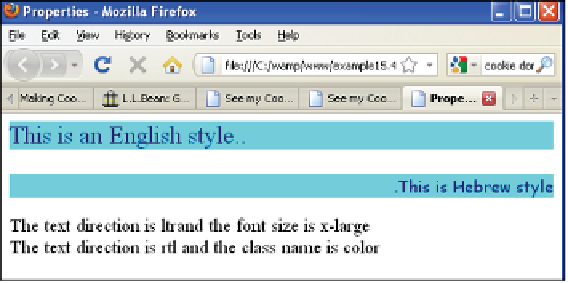HTML and CSS Reference
In-Depth Information
EXPLANATION
(
CONTINUED
)
3
This
p
element is also assigned attributes. The
dir
attribute with
rtl
means the text
will be displayed from the right side of the screen to the left, as would be used with
Arabic or Hebrew.
4
The
getElementById()
method uses the
id
of the first paragraph and returns a ref-
erence to it.
5
The first paragraph has a
dir
and
style
attribute. Using
dir
and
style.fontSize
, Java-
Script can get access to these attributes.
6
The second paragraph has also been assigned attributes. Using the
dir
and
class-
Name
properties, JavaScript can find the direction of the text, right to left, and the
name of the class that is used to style this paragraph. The
className
property can
also be assigned the name of a different class to change the style of the object. The
output is shown in Figure 15.11.
Figure 15.11
Displaying HTML attributes with JavaScript properties.
and Removing Nodes)
You can create new nodes, make a clone of an existing node, insert a new node before
an existing node, remove a node, or replace a node. All of this is possible because the
W3C DOM introduced methods to modify the DOM. Table 15.6 lists the DOM methods.
For a complete list of DOM methods and an excellent resource, go to the JavaScript Kit
page at
http://www.JavaScriptkit.com/domref/elementmethods.shtml.
For another great
resource on how to modify the DOM, go to
http://www.howtocreate.co.uk/tutorials/Java-



